David Dexter: Plumbing systems around the world
While the general principles of plumbing codes appear to be followed in different countries, it seems they are very loosely interpreted.

Codes and standards are intended to provide a minimum level of protection of the public’s health, safety and welfare. And, generally, these documents accomplish that intended purpose in the urban/metropolitan areas of the United States. However, that may not be accurate when one gets into the rural or more isolated areas of the country.
But, let us first provide a definition of “code.” A code is a set of rules or regulations that establish how something must be done to protect the public. These codes should be based on sound science, physics and engineering practice. And, for the most part, this is an accurate basis for these codes especially as the model codes are developed under the ANSI (American National Standards Institute) consensus process. Older codes were developed by trial and error along with field experience, and, in some instances, by a local preference that may lack sound engineering principles behind them. But, over the years, it has become clear that science, physics and engineering principles proved a sound and repeatable basis for the codes. Hence, with each update and revision to the codes, they improve the publics’ health, safety and welfare.
Standards, on the other hand, are written documents used to establish a level of uniformity and quality related to a specific topic. These standards are developed by various societies, manufacturers and interested parties to advance the topic. If these standards are developed under the ANSI process, they can be referenced in the codes. Standards developed outside to the ANSI process may be used by designers and engineers to establish a level of quality or reference a specific process, but they are not recognized as a “nationally recognized standard.”
The model codes that we use in the United States, and which may be utilized in other developed countries, address things such as appropriate temperatures for hot water, protection of potable water through the use of backflow devices, workmanship, materials, etc. And, as a skilled tradesperson, quality and workmanship associated with any design and its installation is important as well as part of one’s individual pride in the design and work.
In the last year, I have had the opportunity to travel and view plumbing installations in many areas of the world to see how others design and install plumbing systems. In the early part of 2022, my wife and I traveled from San Diego, California, to Hawaii (Honolulu, Oahu; Kahilui; Hilo, and Kona) and then onto French Polynesia (Uturoa, Raiatea; Vaitape, Bora Bora; Moorea; Papeete, Tahiti; Fakarava, Tuamotu; Hapatoni, Tahuata; and Taiohae, Nuku Hiva) before returning to San Diego. And to close out the year, we traveled from Fort Lauderdale, Florida, to the Amazon River Basin (Philipsburg, St. Martin; Castries, Saint Lucia; Devil’s Island, French Guiana; Macapa, Brazil; Santarem, Brazil; Alter do Chao, Brazil; Paritins, Brazil; Manaus, Brazil; Boca da Valiera, Brazil; Belem, Brazil; Bridgetown, Barbados; Oranjestad, Aruba; Ocho Rios, Jamaica; and Half Moon Cay, Bahamas before returning to Fort Lauderdale.
Based on my recent travels, as well as previous trips to the Caribbean, United Kingdom, Europe, Netherlands, Iceland, and others, I offer the following observations. These are just my personal observations based on what I witnessed in these areas. While the general principles of the codes appear to be followed, they are very loosely interpreted. Workmanship differs in various parts of the world, with some work done with pride by the craftsperson and others appearing to need additional training. Polymers appear to be the most selected material utilized. I suspect this is based on availability, ease of installation and the lower need for skilled trade knowledge. Additionally, the lack of anti-scalding control means that the individual needs to be responsible for their own well-being. Protection of the potable water systems also seems less prevalent, as the use of backflow protection does not appear to be strongly enforced. These conditions vary between urban areas and rural areas with urban areas appearing to be more likely to have some type of code enforcement.
Another observation would be the plumbing systems utilized on cruise ships. Generally, the sanitary plumbing system on the ship is operated via a vacuum system with holding and processing systems located within the “engine/engineering” spaces within the lower areas of the ship. Just remember, by international law/agreement, 2sanitary materials shall not be discharged into the natural waters of the planet. So these ships must have large sanitary holding storage tanks. Sanitary sewage, as well as garbage and other wastes, are carried until the ship reaches a port that can handle and process these waste materials. Potable water is similar; a large volume must be available for the passengers and staff to use between ports from which the holding storage tanks can be refilled, although, most ships also have the ability to utilize seawater; filtering and processing it into potable water.
And a word of caution for those who travel on cruise ships: the “hot” water is hot regardless of what position the lavatory faucet is placed in. The “cold” water can be sufficiently hot enough to make you pull your hands away very quickly. It will cool down, provided you run it and waste water for a minute or two. But the hot water is well over 150° F most of the time. The lavatory faucet doesn’t appear to have any type of tempering device installed at the point of use. However, this is not the case with the tub or shower faucet. These faucets are different from what we normally see in the United States. They are two-handled with the left handle controlling flow and the right handle used to adjust the temperature. Generally, once the temperature has been set, there is no need to make further adjustments anytime during the cruise. Hence, this faucet would appear to have some type of internal temperature control. I did not find the “public” areas to have the same hot and cold issue that I found in the stateroom.
Having said all of this, I am going to show a series of plumbing photographs providing views of various piping situations for your amusement and welcome any observations or comments that you might have comparing how the United States systems compare with those shown below.
Let’s get started:
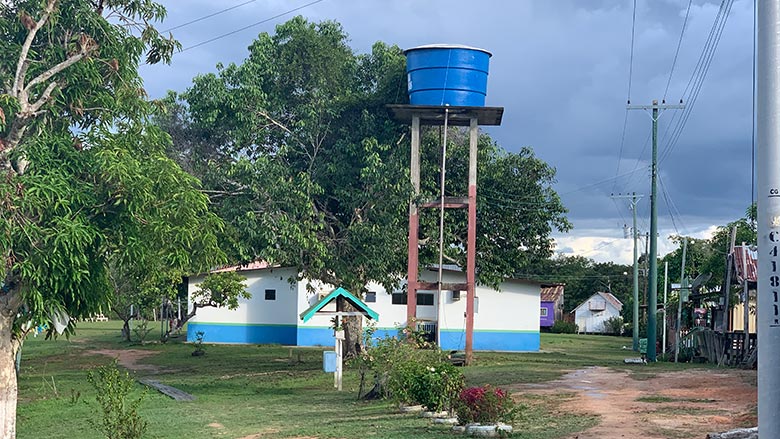 Pictured above, the Manacapuru, Brazil, community water tower collects and distributes rainwater. They have only had electricity for about a year. Before, they ran a generator from 6 p.m. to 10 p.m. every night; the rest of the time there was no electricity.
Pictured above, the Manacapuru, Brazil, community water tower collects and distributes rainwater. They have only had electricity for about a year. Before, they ran a generator from 6 p.m. to 10 p.m. every night; the rest of the time there was no electricity.
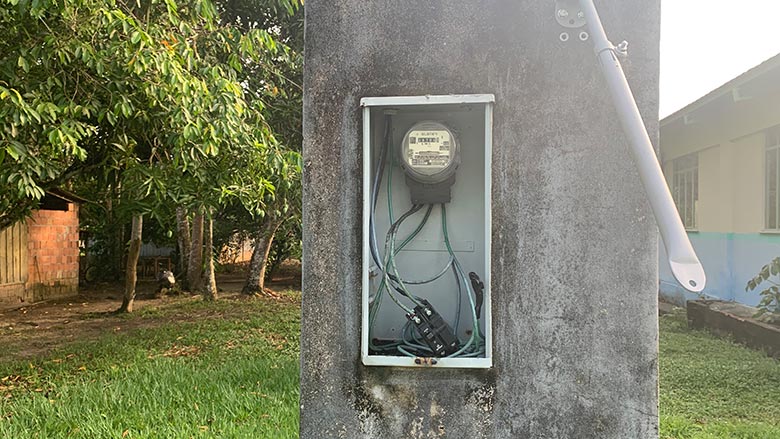 As one can tell from the photo of the Manacapuru, Brazil electric meter above, electrical safety is not a big concern!
As one can tell from the photo of the Manacapuru, Brazil electric meter above, electrical safety is not a big concern!

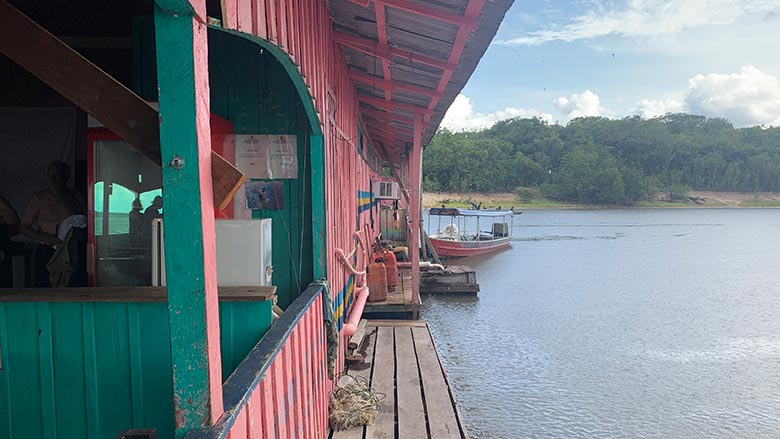 Pictured above, on the Rio Negro River in Brazil, this is a floating business where you visit “Pink Dolphins.” The sanitary is running along the side and wasting into a floating holding tank. One can only wonder where the waste is finally processed or disposed of.
Pictured above, on the Rio Negro River in Brazil, this is a floating business where you visit “Pink Dolphins.” The sanitary is running along the side and wasting into a floating holding tank. One can only wonder where the waste is finally processed or disposed of.
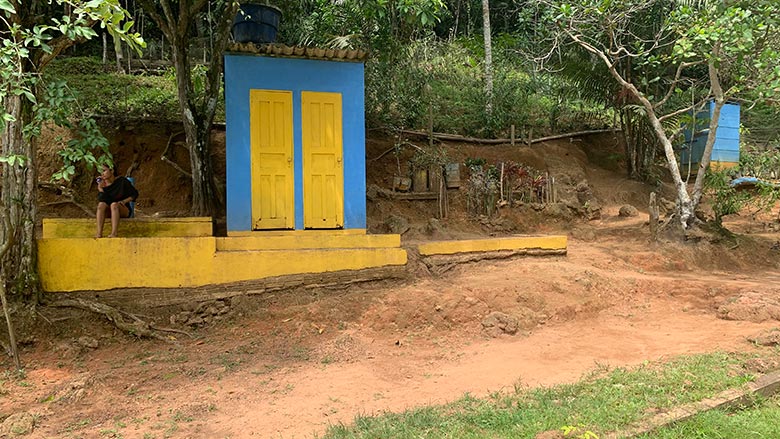 The pictured facility above is a communal outhouse in Partintins, Brazil. This is an indigenous village along another river that feeds the Amazon River. It has only had electricity for about a year.
The pictured facility above is a communal outhouse in Partintins, Brazil. This is an indigenous village along another river that feeds the Amazon River. It has only had electricity for about a year.
 Just some of the residents of the village in native dress, while they let me hold their pet Sloth.
Just some of the residents of the village in native dress, while they let me hold their pet Sloth.
 Pictured in Manaus, Brazil, is a typical water meter installation with a missing cover and trash in the pit.
Pictured in Manaus, Brazil, is a typical water meter installation with a missing cover and trash in the pit.
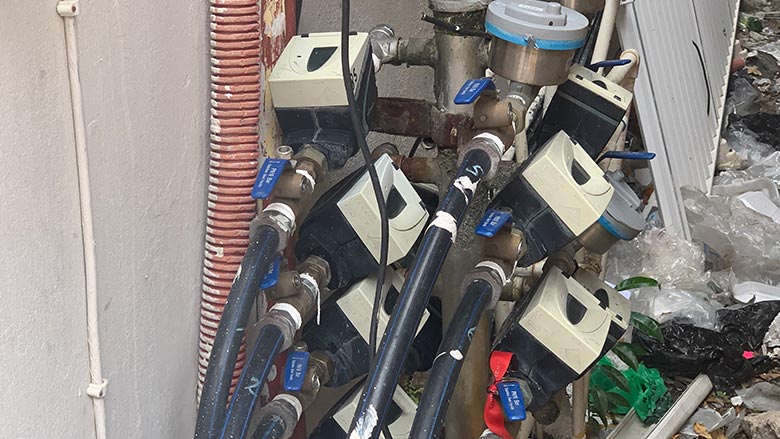 In Philipsburg, St. Martin, a typical, multiple-meter arrangement with no apparent backflow consideration and a lot of trash accumulation around is shown above.
In Philipsburg, St. Martin, a typical, multiple-meter arrangement with no apparent backflow consideration and a lot of trash accumulation around is shown above.
 Above, a typical exterior plumbing installation is shown in Porter, Ireland.
Above, a typical exterior plumbing installation is shown in Porter, Ireland.
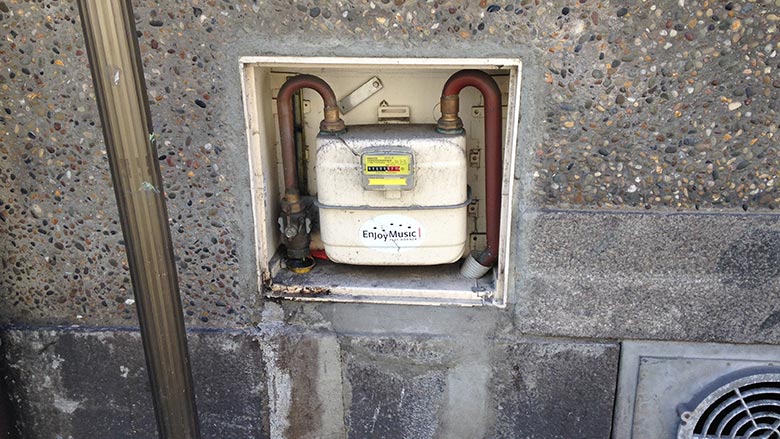 A typical gas meter installation is shown in Cherborg-en-Cotentin, France.
A typical gas meter installation is shown in Cherborg-en-Cotentin, France.
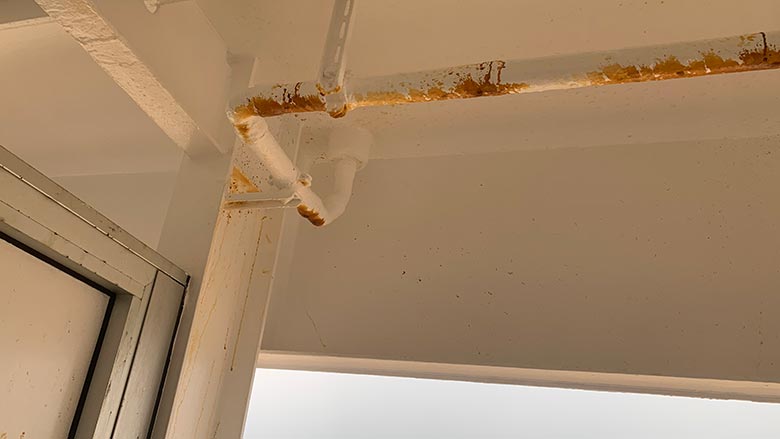 Pictured above is the on-board ship gravity piping system that serves the Veranda deck above. It drains rain/sea/wash-down water. But, as you can see, the stainless steel piping is not totally corrosion resistant. Small pin holes were leaking and the wind distributed the corrosion around the pipe.
Pictured above is the on-board ship gravity piping system that serves the Veranda deck above. It drains rain/sea/wash-down water. But, as you can see, the stainless steel piping is not totally corrosion resistant. Small pin holes were leaking and the wind distributed the corrosion around the pipe.
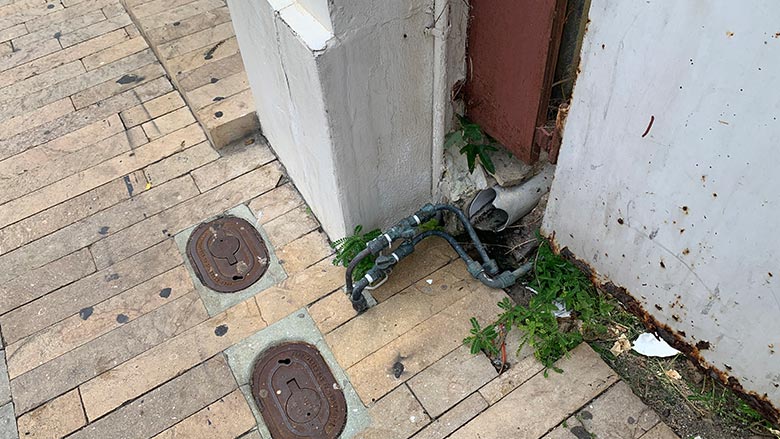 A typical piping arrangement from the meter pit to the building is shown above in Oranjestad, Aruba. Freezing is not a risk.
A typical piping arrangement from the meter pit to the building is shown above in Oranjestad, Aruba. Freezing is not a risk.
 In Bridgetown Barbados, a typical mixture of polymer piping and brass fittings and again freezing is not a risk is pictured above.
In Bridgetown Barbados, a typical mixture of polymer piping and brass fittings and again freezing is not a risk is pictured above.
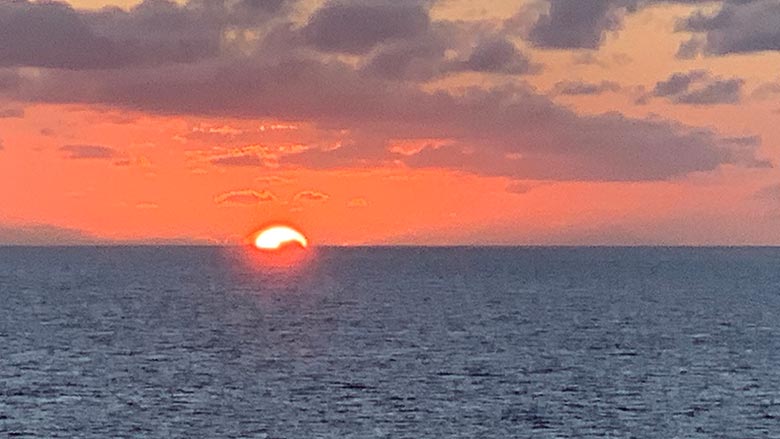 And lastly, once at sea, one gets to enjoy “Happy Hour” while watching the sunset!
And lastly, once at sea, one gets to enjoy “Happy Hour” while watching the sunset!
Looking for a reprint of this article?
From high-res PDFs to custom plaques, order your copy today!







